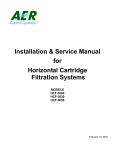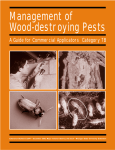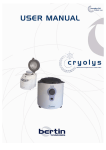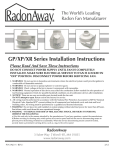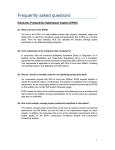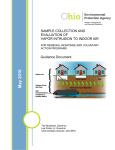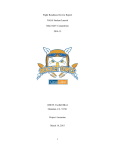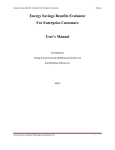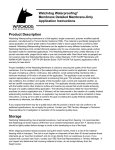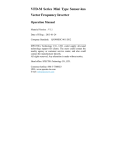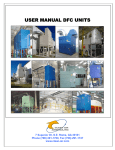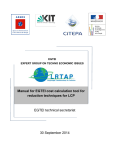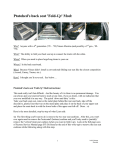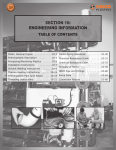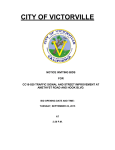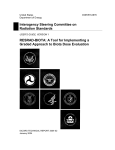Download Pennsylvania Department of Environmental - wpb
Transcript
Pennsylvania Department of Environmental Resources ( DER )
Radon Mitigation Standards (RMS )
CONTENTS
1.0
2.0
3.0
4.0
5.0
6.0
7.0
8.0
9.0
10.0
11.0
12.0
13.0
14.0
15.0
16.0
17.0
18.0
Background…………………………………………………………….1
Purpose…………………………………………………………………2
Participants……………………………………………………………..2
Scope……………………………………………………………………2
Assumption……………………………………………………………..2
Implementatio n…………………………………………………………3
Limitations……………………………………………………………....3
Reference Documents…………………………………………...……5
Description of Terms………………………………………………..…7
General Practices………………………………………………….…..9
Building Investigation………………………………………………...10
Worker Health and Safety…………………………………………...11
Systems Design………………………………………………………13
Systems Installations…………………………………………………14
.1
General Requirements…………………………………….14
.2
Radon Vent Pipe Installation Requirement s…………….14
.3
Radon Vent Fan Installation Requirements……………..15
.4
Suction Pit Requirements for SSD Systems…………….16
.5
Sealing Requirements……………………………………..16
.6
Electrical Requirements……………………………………18
.7
Drain Installation Requirements…………………………..19
.8
HVAC Installation Requirements………………………….19
Materials…………………………………………………………………20
Monitors and Labeling………………………………………………….21
Postmitigation Testing………………………………………………….22
Contracts and Documentation……………………………………...…22
DISCLAIMER…………………………………………………… ………24
1.0 BACKGROUND
The 1988 Indoor Radon Abatement Act (IRAA) required the Environmental Protection Agency
(EPA) to develop a voluntary program to evaluate and provide information on contractors who
offer radon control services to homeowners. The Radon Contractor Proficiency (RCP) Program
was established to fulfill this portion of the IRAA. In December 1991, EPA published "Interim
Radon Mitigation Standards" as initial guidelines for evaluating the performance of radon
mitigation contractors under the RCP Program. Over the past six years, the effectiveness of the
basic radon mitigation techniques set forth in the "Interim Standards" has been validated in field
applications throughout the United States. This experience now serves as the basis for the more
1 of 24
Pennsylvania Department of Environmental Resources ( DER )
Radon Mitigation Standards (RMS )
detailed and final Pennsylvania Radon Mitigation Standards (PA RMS) set forth in this
document.
2.0 PURPOSE
The purpose of the PA RMS is to provide radon mitigation contractors with uniform standards
that will ensure quality and effectiveness in the design, installation, and evaluation of radon
mitigation systems in detached and attached residential buildings three stories or less in height.
The PA RMS is intended to serve as a model set of requirements which have been adopted by
the Pennsylvania Department of Environmental Protection (PA DEP) to fulfill the requirements
of the Radon Certification Act, 25 Pa. Code, Chapter 240.
3.0 PARTICIPANTS
The minimum requirements for individuals or firms who perform radon remediation work within
the Commonwealth, include: completion of Radon Certification Application (Radon Mitigation),
attend a Department approved course, have one year radon mitigation experience or three years
experience in architecture, engineering, electrical, plumbing,carpentry, masonry, or related
trades, pass the EPA Radon Contractors Proficiency exam, and submit the required fee.
4.0 SCOPE
The requirements addressed in the PA RMS include the following categories of contractor
activity: general practices, building investigation, worker health and safety, systems design,
systems installation, materials, monitors and labeling, post mitigation testing, and contacts and
documentation.
5.0 ASSUMPTION
Before applying the provisions of the PA RMS, it is assumed that appropriate radon/radon decay
product measurements have been performed within the structure, and that the owner has decided
that radon remediation is necessary.
6.0 IMPLEMENTATION
6.1 The PA RMS includes requirements for installation of radon remediation systems and
provides a basis for evaluating the quality of those installations. All PA DEP certified
contractors are required to follow all requirements set forth in the PA RMS.
6.2 Contractors shall personally conduct follow-up inspection of any radon mitigation system
installed by their firm that was changed from the original certified contractors design.
2 of 24
Pennsylvania Department of Environmental Resources ( DER )
Radon Mitigation Standards (RMS )
Additionally, contractors shall inspect 20 percent of all other installations, within 30 days of
system completion to insure continued conformance to PA RMS.
6.3 PA DEP will inspect radon mitigation systems installed by DEP- certified contractors for
compliance with this standard and the PA DEP Radon Certification Regulations (25 Pa. Code
Ch. 240). Violations of these standards and regulations may result in decertification, suspension
of certification, or civil penalties. Additionally, state radon program personnel are considered
agents of the US EPA, and as such any inspection finding may be forwarded to the US EPA for
evaluation of noncomplia nce with these standards. Based on its evaluation, the US EPA may
initiate established Radon Contractor Proficiency program delisting procedures against those
contractors found to be in violation of these standards.
6.4 Those provisions of the PA RMS that are considered to be mandatory are prefaced by the
term "shall." Provisions that are considered good practice but which are not mandatory are
prefaced by the terms "should" or "recommended."
6.5 The PA RMS will be updated as necessary, and in response to technological advances and
field experience. The scope of the PA RMS will also be expanded when new revised mitigation
technologies have been demonstrated in other types of residential and nonresidential buildings.
6.6 For areas of radon mitigation not covered by this standard, the contractor shall follow the
guidance outlined in the reference documents (See paragraph 8.0) and his/her training obtained
in PA DEP approved radon mitigation courses.
7.0 LIMITATIONS
7.1 Although the provisions of the PA RMS have been carefully reviewed for potential
conflicts with other regulatory requirements, adherence to the PA RMS does not guarantee
compliance with the applicable codes or regulations of any other Federal, state or local agency
having jurisdiction.
7.2 Where discrepancies exist between provisions of the PA RMS and local codes or
regulations, local codes shall take precedence. However, where compliance with local codes
necessitates a deviation from the PA RMS, or a deviation is required for research or other
purposes, the PA DEP requires contractors to give written notification of these deviations prior
to initiation of work.
7.3 The PA RMS is not intended to be used as a design manual, and compliance with its
provisions will not guarantee reduction of indoor radon concentrations to any specific level.
3 of 24
Pennsylvania Department of Environmental Resources ( DER )
Radon Mitigation Standards (RMS )
7.4 The PA RMS shall not apply to radon mitigation systems installed prior to its effective
date. However, if a radon mitigation system is found that does not comply with current
standards, the contractor shall recommend in writing to the client that the system be upgraded or
altered to meet current standards. The contractor shall obtain prior approval from the client
before implementing any of the contractors written recommendations.
7.5 Because of the wide variation in building design, size, operation and use, the PA RMS
does not include detailed guidance on how to select the most appropriate mitigation strategy for
a given building. That guidance is provided in the documents referenced in paragraphs 8.2, 8.3,
8.4, and 8.5.
7.6 The provisions of the PA RMS are limited to proven technologies and methods.
Publication of this standard is not intended, however, to inhibit research and evaluation of other
innovative radon mitigation techniques. When such research is conducted, a performance
standard shall be applied, i.e., postmitigation radon levels shall be less than 4 pCi/l, and the
systems design criteria in paragraph 13.0 shall be applied. A contractor who expects to deviate
from proven radon mitigation technologies and methods (as defined in the PA RMS and other
EPA references in Section 8.0) for purposes of research on innovative mitigation techniques, or
for other reasons, shall, prior to initiation of work, obtain approval from PA DER, document the
nonstandard techniques, and inform the client of the deviation from standard procedures.
7.7 At this time, the PA RMS does not include standards for installing systems to mitigate
radon in water. However, EPA is currently developing a standard that will regulate radon levels
in domestic water supplies. Following publication of that standard, the PA RMS may be revised,
as appropriate, to include standards for installation of systems that are effective in reducing
radon levels in water.
8.0 REFERENCE DOCUMENTS
The following documents are sources of additional radon mitigation information and are
recommended reading for contractors participating in the RCP program.
8.1
EPA Radon Mitigation Standards, April 1994 Revised Edition. EPA 402-R- 93-078.
8.2
EPA Training Manual "Reducing Radon In Structures," (Third Edition), January 1993.
8.3 "Radon Reduction Techniques for Detached Houses, Technical Guidance (Second
Edition)" EPA/625/5 -87/019, January 1988.
8.4 "Radon Reduction Techniques for Existing Detached Houses, Technical Guidance (Third
Edition) for Active Soil Depressurization Systems" EPA/625/R - 93/011, October 1993.
4 of 24
Pennsylvania Department of Environmental Resources ( DER )
Radon Mitigation Standards (RMS )
8.5
"Application of Radon Reduction Methods," EPA/625/5 -88/024, August 1988.
8.6 "Indoor Radon and Radon Decay Product Measurement Device Protocols," EPA
402-R-92-004, July, 1992.
8.7 "Protocols for Radon and Radon Decay Product Measurements in Homes," EPA
402-R-92-003, June, 1993
8.8
"A Citizen's Guide to Radon (Second Edition)" EPA 402-K92-001, May 1992.
8.9 "Pennsylvania's Consumer's Guide to Radon Reduction," EPA, 402-K92-003, August,
1992.
8.10 "Pennsylvania's Home Buyer's and Seller's Guide to Radon," EPA 402-R-93-003, March,
1993.
8.11
"ASHRAE Standard 62-1989," Appendix B, Positive Combustion Air Supply.
8.12 "National Gas Code," Appendix H (p.2223. 1-98), 1988, Recommended Procedure for
Safety Inspection of an Existing Appliance Installation.
8.13 "Chimney Safety Tests User's Manual," Second Edition, January 12, 1988, Scanada
Shelter Consortium Inc., for Canada Mortgage and Housing Corp.
8.14 “The Spillage Test” Method to Determine the Potential for Pressure-Induced Spillage
from Vented, Fuel-Fired, Space Heating Appliance s, Water Heaters and Fireplaces. Canadian
General Standards Board. CAN/CGSB -51.71-95, April 1995.
8.15 OSHA "Safety and Health Regulations for Construction, Ionizing Radiation," 29 CFR
1926.53.
8.16 OSHA "Occupational Safety and Health Regulations, Ionizing Radiation," 29 CFR
1910.96.
8.17 NIOSH "Guide to Industrial Respiratory Protection," DHHS (NIOSH) Publication NO.
87-116, September 1987.
8.18 NCRP "Measurement of Radon and Radon Decay Daughters in Air," NCRP Report No.
97, Nov 1988.
5 of 24
Pennsylvania Department of Environmental Resources ( DER )
Radon Mitigation Standards (RMS )
8.19 EPA "Handbook, Sub-Slab Depressurization for Low-Permeability Fill Material,"
EPA/625/6 -91/029, July 1991.
9.0 DESCRIPTION OF TERMS
For this document, certain terms are defined in this section. Terms not defined herein should
have their ordinary meaning within the context of their use. Ordinary meaning is as defined in
"Webster's Ninth New Collegiate Dictionary."
9.1 Backdrafting: A condition where the normal movement of combustion products up a flue,
resulting from the buoyant forces on the hot gases, is reversed, so that the combustion products
can enter the structure. Backdrafting of combustion appliances (such as fireplaces and furnaces)
can occur when depressurization in the structure overwhelms the buoyant force on the hot gases.
Backdrafting can also be caused by chimney blockage.
9.2 Backer Rod: A semirigid closed cell foam material resembling a rope of various
diameters. Used to fill around pipes, large cracks etc. to assist in making a sealed penetration.
For example, where a pipe is inserted through a concrete slab, a length of backer rod is
compressed into the opening around the pipe. Caulking is then applied to the space above the
backer rod and between the outside of the pipe and the slab opening. The purpose of the backer
rod is to hold the semifluid caulk in place until it sets or hardens, and act as a bond breaker.
9.3 Block Wall Depressurization: A radon mitigation technique that depressurizes the void
network within a block wall foundation by drawing air from inside the wall and venting it to the
outside.
9.4 CCA treated for ground contact: Chromated Copper Arsenate (CCA) applied at a rate of
0.4 lb\Cu Ft allows wood to be in ground contact. Lumber treated at a rate of 0.25 lb\Cu Ft is
not intended for ground contact.
9.5 Certified: A rating applied by the PA DEP to individuals or firms that are authorized to
provide radon related services within the Commonwealth.
9.6 Client: The person, persons, or company that contracts with a radon mitigation contractor
to install a radon reduction system in a building.
9.7 Combustion Appliance: Any device which utilizes the ignition of a fuel to perform work
for a specific purpose including but not limited to heating, drying, cooling, and refrigeration.
9.8 Combination Foundation: Buildings constructed with more than one foundation type,
e.g., basement/crawlspace or basement/slab on-grade.
6 of 24
Pennsylvania Department of Environmental Resources ( DER )
Radon Mitigation Standards (RMS )
9.9 Communication Test: A diagnostic test designed to qualitatively measure the ability of a
suction field and air flow to extend through the material beneath a concrete slab floor and thus
evaluate the potential effectiveness of a subslab depressurization system. This test is commonly
conducted by applying suction to a hole drilled through the slab where a future suction hole
might be located and simultaneously measuring the pressure differential or observing the
movement of smoke downward into small holes drilled in the slab at locations away from the
suction hole. (See also paragraph 9.19, Pressure Field Extension).
9.10 Contractor: An individual or firm listed with the PA DEP as being certified to perform
radon mitigation activities.
9.11 Crawlspace Depressurization: A radon control technique designed to achieve lower air
pressure in the crawlspace relative to indoor air pressure by use of a fan-powered vent drawing
air from within the crawlspace. (See also paragraph 9.15 Mechanically Ventilated Crawlspace
System.)
9.12 Diagnostic Tests: Procedures used to identify or characterize conditions within buildings
that may contribute to radon entry or elevated radon levels or may provide information regarding
the performance of a mitigation system.
9.13 Drain Tile Loop: A continuous length of drain tile or perforated pipe extending around
all or part of the internal or external perimeter of a basement or crawlspace footing.
9.14 Mitigation System: Any system or steps designed to reduce radon concentrations in the
indoor air of a building.
9.15 Mechanically Ventilated Crawlspac e System: A radon control technique designed to
increase ventilation within a crawlspace, achieve higher air pressure in the crawlspace relative to
air pressure in the soil beneath the crawlspace, or achieve lower air pressure in the crawlspace
relative to air pressure in the living spaces, by use of a fan. (See also paragraph 9.11, Crawlspace
Depressurization.)
9.16 Natural Draft Appliance: Any combustion appliance that does not have fan forced
combustion venting and therefore is more likely to be susceptible to backdrafting.
9.17 pCi/l: The abbreviation for picocuries per liter which is a unit of measure for the amount
of radioactivity in a liter of air. There are 2.2
disintegrations per minute of radioactive
material in 1 picocurie.
7 of 24
Pennsylvania Department of Environmental Resources ( DER )
Radon Mitigation Standards (RMS )
9.18 Perimeter Channel Drain: A means for collecting water in a basement by means of a
large gap or channel between the concrete floor and the wall. Collected water may flow to
aggregate beneath the channel ("French Drain") or to a sump where it can be drained or pumped
away.
9.19 Pressure Field Extension: The distance that a pressure change is induced in the subslab
area, measured from a single or multiple suction points. (See also paragraph 9.9,
Communication Test.)
9.20 Radon: A naturally occurring radioactive element (Rn-222) which exists as a gas and is
measured in picocuries per liter (pCi/L).
9.21 Radon Resistant Drain: A floor drain that has a check valve that minimizes air flow if
the drain trap dries up or the trapped drain has an automatic supply of priming water.
9.22 Radon Decay Products: The four short-lived radioactive elements (Po-218, Pb-214,
Bi-214, Po-214) which exist as solids and immediately follow Rn-222 in the decay chain. They
are measured in units of working levels (WL).
9.23 Reentrainment: The unintended re-entry into a building of radon that is being exhausted
from a radon mitigation system.
9.24
Soil Gas: The gas mixture present in soil which may contain radon.
9.25 Soil Gas Retarder: A continuous membrane or other comparable material used to retard
the flow of soil gases into a building.
9.26 Stack Effect: The overall upward movement of air inside a building that results from
heated air rising and escaping through openings in the building envelope, thus causing indoor air
pressure in the lower portions of a building to be lower than the pressure in the soil beneath or
surrounding the building foundation.
9.27 Submembrane Depressurization: A radon control technique designed to achieve lower
air pressure in the space under a soil gas retarder membrane laid on the crawlspace floor, relative
to air pressure in the crawlspace, by use of a fan powered vent drawing air from beneath the
membrane. Complete sealing of these membranes is recommended.
9.28 Subslab Depressurization (Active): A radon control technique designed to achieve
lower subslab air pressure relative to indoor air pressure by use of a fan powered vent drawing
air from beneath the concrete slab.
8 of 24
Pennsylvania Department of Environmental Resources ( DER )
Radon Mitigation Standards (RMS )
9.29 Subslab Depressuri zation (Passive): A radon control technique designed to achieve
lower subslab air pressure relative to indoor air pressure by use of a vent pipe (without a fan)
routed through the conditioned space of a building and connecting the subslab area to the
outdoor air. This system relies solely on wind induced vent pipe draft and the convective flow of
warmed air upward in the vent to draw air from beneath the concrete slab.
9.30 Working Level (WL): A unit of radon decay product concentration. Numerically, any
combination of short-lived radon decay products in one liter of air that will result in the ultimate
emission of 130,000 MeV of potential alpha energy. This number was chosen because it is
approximately the total alpha energy released from the short-lived decay products in equilibrium
with 100 pCi of Rn-222 per liter of air. (See also the referenced document in paragraph 8.16).
9.31 Working Level Month (WLM): A unit of exposure used to express the accumulated
human exposure to radon decay products. It is calculated by multiplying the average working
level to which a person has been exposed by the number of hours exposed and dividing the
product by 170.
10.0 GENERAL PRACTICES
The following general practices are required for all contacts between radon mitigation
contractors and clients.
10.1 In the initial contact with a client, the contractor shall review any available results from
previous radon tests to assist in developing an appropriate mitigation strategy. The contractor
shall inform the client when it is determined that previous radon measurements were not
performed according to EPA protocols and recommend a retest be done.
10.2 Based on guidance contained in "A Citizen's Guide to Radon (Second
Edition),"(paragraph 8.8) and the "PA Home Buyers and Seller's Guide" or subsequent revisions
of these documents, the contractor shall refer the client to the discussions of interpreting indoor
radon test results and the health risk associated with the radon level found in the building. The
"Pennsylvania Consumer's Guide To Radon Reduction,"(paragraph 8.9) is an appropriate
reference for providing advice on actions to take to reduce indoor radon levels.
10.3 When delays in the installation of a permanent radon control system are unavoidable due
to building conditions or construction activities, and a temporary system is installed; the
contractor shall inform the client about the temporary nature of the system. A label that is
readable from at least three feet shall be placed on the system. The label shall include a
statement that the system is temporary and that it will be replaced with a permanent system
within 30 days. The label shall also include the date of installation, and the contractor's name,
phone number, and PA DEP certification Identification Number. (EXCEPTION: The 30 day
9 of 24
Pennsylvania Department of Environmental Resources ( DER )
Radon Mitigation Standards (RMS )
limit on use of a temporary mitigation system may be extended in cases where a major
renovation or change in building use necessitates a delay in installation of a permanent
mitigation system that is optimized to the new building configuration or use. DEP’s Bureau of
Radiation Protection should be notified in writing when this exception is being applied.)
10.4 When the selected mitigation technique requires use of sealants or caulks containing
volatile solvents, prior to starting work, the contractor shall inform the client in writing (this
could include an MSDS sheet) of the need to ventilate work areas during and after the use of
such sealants. Ventilation shall be provided as recommended by the manufacturer of the
material.
11.0 BUILDING INVESTIGATION
11.1 The contractor shall conduct a thorough visual inspection of the building prior to
initiating any radon mitigation work. This inspection should be performed prior to submission of
the bid proposal to the client. The inspection is intended to identify any specific building
characteristics or configurations (e.g., large cracks in slabs, exposed earth in crawlspaces, open
sump pits, wet basement or foundation walls) that may affect the design, installation, and
effectiveness of radon mitigation systems. As a part of this inspection, clients should be asked to
provide any available information about the building (e.g., construction specifications, pictures,
drawings, etc.) that might be of value in determining the radon mitigation strategy.
11.2 To facilitate selection of the most effective radon control system and avoid the cost of
installing systems that subsequently prove to be ineffective, it is recommended that the
contractor conduct diagnostic tests to assist in identifying and verifying suspected radon sources,
entry points, and subslab communication. Radon grab sampling, communication tests, and use
of chemical smoke sticks are examples of the type of diagnostic testing commonly used. (See
paragraph 11.4).
11.3 It is recommended that during the building investigation, the contractor routinely perform
diagnostic tests to evaluate the existence of, or the potential for, backdrafting of natural draft
combustion appliances. Published procedures for conducting backdrafting tests are covered in
the Reference Documents listed in paragraphs 8.11, 8.12,8.13 and 8.14. The following checklist
has been extracted from material in these references and may be used to test for existing or
potential backdrafting conditions:
(1) Close all external windows and doors and the door between the basement and the first floor.
(2) Turn off all natural draft appliances.
(3) Close fireplace and wood stove dampers.
10 of 24
Pennsylvania Department of Environmental Resources ( DER )
Radon Mitigation Standards (RMS )
(4) Turn on all exhaust fans and any forced air distribution fans.
(5) Wait at least 5 minutes after natural draft appliances have been turned off.
(6) To begin a test for actual spillage of flue gases, turn on the appliance being tested.
(7) Using either a chemical smoke or a carbon dioxide gas analyzer, check for flue gas spillage
near the vent hood after appliance has been running for five minutes.
(8) Repeat steps (5) through (7) for each natural draft combustion appliance being tested for
backdrafting. Be sure to turn off any combusti on appliances that feed into the same chimney as
the natural draft appliance being tested. Seasonal and extreme weather conditions should be
considered when evaluating pressure differentials and the potential for backdrafting.
If spillage is confirmed from any natural draft combustion appliance, clients shall be advised of
the backdrafting condition and that active (fan powered) radon mitigation systems cannot be
installed until the condition has been corrected. The contractor should advise the client to contact
an HVAC contractor if correcting an existing or potential backdrafting condition is necessary.
(See paragraph 17.3 for post- mitigation backdrafting test).
11.4 If installation of a subslab depressurization system is contemplated and characteristics of
the subslab material are unknown, a communication test, as defined in paragraph 9.9 is
recommended.
11.5 As part of the building investigation, a floor plan sketch shall be developed (if not already
in existence and readily available) that includes illustrations of the building foundation
(slab-on-grade, basement or crawlspace area). The sketch should include the location of load
bearing walls, drains, sump pits, HVAC systems and natural draft appliances. It shall be
annotated to include the anticipated layout of any radon mitigation system piping, and the
anticipated locations of any vent fan and system warning devices for the envisioned mitigation
systems. The sketch shall be finalized during installation and shall be included in the
homeowner information package. (paragraph 18.5).
12.0 WORKER HEALTH AND SAFETY
12.1 The contractor shall comply with all OSHA, state and local standards or regulations
relating to worker safety and occupational radon exposure. Applicable references in the Code of
Federal Regulations and NIOSH publications (or subsequent updates) are listed in paragraphs
8.15, 8.16, and 8.17.
11 of 24
Pennsylvania Department of Environmental Resources ( DER )
Radon Mitigation Standards (RMS )
12.2 In addition to the OSHA and NIOSH standards, the following requirements that are
specifically or uniquely applicable for the safety and protection of radon mitigation workers shall
be met:
12.2.1 The contractor shall advise workers of the hazards of exposure to radon and the need
to apply protective measures when working in areas of elevated radon concentrations.
12.2.2 The contractor shall have a worker protection plan on file that is available to all
employees and is approved by the PA DEP.
12.2.3 The contractor shall ensure that appropriate safety equipment such as hard hats, face
shields, ear plugs and protective gloves are available on the job site during cutting, drilling,
grinding, polishing, demolishing or other hazardous activity associated with radon mitigation
projects. The contractor shall ensure that all new employees have been informed about all
relevant portions of the company worker protection plan. All relevant portions of the worker
protection plan shall be reviewed with each employee at least once a year. Confirmation of
employees' knowledge of relevant portions of the worker protectio n plan should be recorded
with the employees' signature and date.
12.2.4 All electrical equipment used during radon mitigation projects shall be properly
grounded. Circuits used as a power source should be protected by Ground-fault Circuit
Interrupters (GFCI).
12.2.5 When work is required at elevations above the ground or floor, the contractor shall
ensure that ladders or scaffolding are safely installed and operated.
12.2.6 Work areas shall be ventilated to reduce worker exposure to radon decay products,
dust, or other airborne pollutants. In work areas where premitigation levels have been greater
than 0.33 WL (66 pCi/l) and where ventilation is impractical or where ventilation cannot reduce
decay product levels to less than 0.33 WL (66 pCi/l) (based on a short term test), the contractor
should ensure that respiratory protection conforming with the requirements in the NIOSH Guide
to Industrial Respiratory Protection is available on the job site. (See paragraph 8.17.).
12.2.7 Where combustible materials exist in the specific area of the building where radon
mitigation work is to be conducted and the contractor is creating any temperatures high enough
to induce a flame, the contractor shall ensure that a fire extinguisher suitable for type A, B, and
C fires is available in the immediate work area.
12.2.8 Pending development of an approved personal radon exposure device and a protocol for
its use, the contractor shall record employee exposure to radon at each work site, based on: (1)
the highest pre-mitigation indoor radon or working level measurement available, and (2) the time
12 of 24
Pennsylvania Department of Environmental Resources ( DER )
Radon Mitigation Standards (RMS )
employee's are exposed (without respirator protection) at that level (See paragraph 12.2.6).
(Note: This approach is not intended to preclude the alternative use of on-site radon or radon
decay product measurements to help determine actual exposure.) Consistent with OSHA
Permissible Exposure Limits, the contractor shall ensure that employee's are exposed to no more
than 4 working level months (WLM) over a 12 month period. (An equilibrium ratio of 50
percent shall be used to convert radon exposure to WLM.) If a contractor is a sole proprietor of
a radon mitigation firm they are still responsible for recording and maintaining their own
occupational radon/radon progeny exposure.
12.2.9 In any area where building materials containing friable asbestos have been identified,
or it is suspected that friable asbestos may exist, radon mitigation work shall not be conducted
without the approval of an inspector or mitigator certified under provisions of the Asbestos
Hazards Emergency Response Act (AHERA) and the Pennsylvania Department of Labor and
Industry Act 194.
12.2.10 When mitigation work requires the use of sealants, adhesives, paints, or other
substances that may be hazardous to health, the contractor shall provide employee's with the
applicable Material Safety Data Sheets (MSDS) and explain the required safety procedures.
13.0 SYSTEMS DESIGN
13.1 All radon mitigation systems shall be designed and installed as permanent, integral
additions to the building, except where a temporary system has been installed in accordance with
paragraph 10.3. The radon mitigation system shall exist as a stand alone system and not
incorporate other house systems or features in its design.
13.2 All radon mitigation systems shall be designed to avoid the creation of other health,
safety, or environmental hazards to building occupants, such as backdrafting of natural draft
combustion appliances.
13.3 All radon mitigation systems shall be designed to maximize radon reduction, while
minimizing excess energy usage, avoiding compromise of moisture and temperature controls and
other comfort features, and minimizing noise.
13.4 All radon mitigation systems and their components shall be designed to comply with the
laws, ordinances, codes, and regulations of relevant jurisdictional authorities, including
applicable mechanical, electrical, building, plumbing, energy, and fire prevention codes.
13 of 24
Pennsylvania Department of Environmental Resources ( DER )
Radon Mitigation Standards (RMS )
14.0 SYSTEMS INSTALLATION
14.1
General Requirements
14.1.1 All components of radon mitigation systems installed in compliance with provisions
of the PA RMS shall also be in compliance with the applicable mechanical, electrical, building,
plumbing, energy and fire prevention codes, standards, and regulations of the local jurisdiction.
14.1.2 The contractor shall obtain all required licenses and permits, and display them in the
work areas as required by local ordinances.
14.1.3 Where portions of structural framing material must be removed to accommodate
radon vent pipes, material removed shall be no greater than that permitted for plumbing
installations by applicable building or plumbing codes.
14.1.4 Where installation of a radon mitigation system requires pipe or ducts to penetrate a
firewall or other fire resistance rated wall or floor, penetrations shall be protected in accordance
with applicable building, mechanical, fire, and electrical codes.
14.1.5 When installing radon mitigation systems that use sump pits as the suction point for
active soil depressurization, if sump pumps are needed, it is recommended that submersible
sump pumps be used. (See paragraphs 14.5.1, 14.7.4, 15.7, and 15.8.)
14.2
Radon Vent Pipe Installation Requirements
14.2.1 All joints and connections in radon mitigation system vent pipes shall be permanently
sealed as specified by the manufacturer, with the exception that flexible rubber couplings are an
allowable alternative method.
14.2.2 Radon vent pipe runs subjected to cold environments should be insulated to prevent
vent pipe freeze up. Radon vent pipes in attics where warm, moist environments exist should
also be insulated to reduce condensation on exterior pipe surfaces.
14.2.3 Radon vent pipes shall be fastened to the structure of the building with hangers,
strapping, or other supports that will adequately secure the vent material. Existing plumbing
pipes, ducts, or mechanical equipment shall not be used to support or secure a radon vent pipe.
14.2.4 Supports for radon vent pipes shall be installed at least every 6 feet on horizontal runs
to eliminate vertical or horizontal movement. Vertical runs shall be secured either above or
below the points of penetration through floors, ceilings, and roofs, or at least every 8 feet on runs
that do not penetrate floors, ceilings, or roofs.
14 of 24
Pennsylvania Department of Environmental Resources ( DER )
Radon Mitigation Standards (RMS )
14.2.5 To prevent blockage of air flow into the bottom of radon vent pipes, these pipes shall
be supported or secured in a permanent manner that prevents their downward movement to the
bottom of suction pits or sump pits, or into the soil beneath an aggregate layer under a slab.
14.2.6 Radon vent pipes shall be installed in a configuration that ensures that any rain water
or condensation within the pipes drains downward into the ground beneath the slab or soil-gas
retarder membrane.
14.2.7 Radon vent pipes shall not block access to any areas requiring maintenance or
inspection, unless the vent pipe is designed for easy removal and air tight replacement. Radon
vent pipes shall not be installed in front of or interfere with any light, opening, door, window or
equipment access area required by code. If radon vent pipes are installed in sump pits (with
sump pumps), the system shall be designed with removable, air tight, couplings to facilitate
removal and reinstallation of the vent pipes and sump pit cover for sump pump maintenance.
14.2.8 To prevent reentrainment of radon, the point of discharge from vents of fan powered
soil depressurization and block wall depressurization systems shall meet all of the following
requirements: (1) be above the eave of the roof, (2) be ten feet or more above ground level, (3)
be ten feet or more from any window, door, or other opening into conditioned spaces of the
structure that is less than two feet below the exhaust point, and (4) be ten feet or more from any
opening into an adjacent building. The total required distance (ten feet) from the point of
discharge to openings in the structure may be measured either directly between the two points or
be the sum of measurements made around intervening solid obstacles.
14.2.9 When a radon mitigation system is designed to draw soil gas from a perimeter drain
tile loop (internal or external) that discharges water through a drain line to daylight or a soak
away, a one-way valve, water trap, or other control device should be installed in or on the
discharge line to prevent outside air from entering the system while allowing water to flow out of
the system.
14.3
Radon Vent Fan Installation Requirements
14.3.1 Vent fans shall be designed specifically for radon removal applications and be
designed or otherwise sealed to reduce the potential for leakage of soil gas from the fan housing.
14.3.2 Radon vent fans should be sized to provide the pressure difference and air flow
characteristics necessary to achieve the radon reduction goals established for the specific
mitigation project. Guidelines for sizing vent fans and piping can be found in the references
cited in paragraph 8.2, 8.4, and 8.19.
15 of 24
Pennsylvania Department of Environmental Resources ( DER )
Radon Mitigation Standards (RMS )
14.3.3 Radon vent fans used in active soil depressurization or block wall depressurization
systems shall not be installed below grade nor in the conditioned (heated/cooled) space of a
building, nor in any basement, crawlspace, or other interior location directly beneath the
conditioned spaces of a building. Acceptable locations for radon vent fans include attics not
suitable for occupancy (including attics over living spaces and garages), garages that are not
beneath conditioned spaces, or on the exterior of the building.
14.3.4 Radon vent fans shall be installed in a configuration that avoids condensation buildup
in the fan housing. Active soil depressurization fans shall be installed in vertical runs of the vent
pipe.
14.3.5 Radon vent fans mounted on the exterior of buildings shall be rated for outdoor use or
installed in a water tight protective housing.
14.3.6 Radon vent fans shall be mounted and secured in a manner that minimizes transfer of
vibration to the structural framing of the building.
14.3.7 To facilitate maintenance and future replacement, radon vent fans shall be installed in
the vent pipe using removable, air tight couplings or flexible connections that can be tightly
secured to both the fan and the vent pipe.
14.3.8 The intakes of fans used in crawlspace pressurization, or in pressurizing the building
itself, shall be screened or filtered to prevent ingestion of debris or personal injury. Screens or
filters shall be removable to permit cleaning or replacement and building owners shall be
informed of the need to periodically replace or clean such screens and filters. This information
shall also be included in the documentation. (See paragraph 18.5).
14.4
Suction Pit Requirement for Subslab Depressurization (SSD) Systems
14.4.1 To provide optimum pressure field extension of the subslab communication zone, a
minimum of 1/2 cubic foot (i.e. approx. half of a 5 gallon bucket) of material shall be excavated
(unless bedrock prohibits this) from the area immediately below the slab penetration point of
SSD system vent pipes.
14.5
Sealing Requirements
14.5.1 Sump pits that permit entry of soil-gas or that would allow conditioned air to be drawn
into a subslab depressurization system shall be covered and sealed. The sump cover shall have a
radon resistant drain (See paragraph 9.21) if there is no other available floor drain. (Homeowner
information should indicate periodic filling, if applicable.) See paragraph 15.7 for details on
sump cover and sealing materials.
16 of 24
Pennsylvania Department of Environmental Resources ( DER )
Radon Mitigation Standards (RMS )
14.5.2 Openings around radon vent pipe penetrations of the slab, the foundation walls, and
the crawlspace soil-gas retarder membrane shall be cleaned, prepared, and sealed in a
permanent, airtight manner using compatible caulks or other sealant materials. (See paragraph
15.5) Openings around other utility penetrations of the slab, walls, or soil-gas retarder shall also
be sealed.
14.5.3 Where a Block Wall Depressurization (BWD) system is used to mitigate radon,
openings in the tops of such walls and all accessible openings or cracks in the interior surfaces of
the walls shall be closed and sealed with urethane or equivalent caulks, expandable foams, rigid
board stock caulked in place, nonshrink grout or other comparable materials. (See paragraphs
15.5 and 15.6.) Openings or cracks that are determined to be inaccessible or beyond the ability
of the contractor to seal shall be disclosed to the client and included in the documentation.
14.5.4 Openings, perimeter channel drains, or cracks that exist where the slab meets the
foundation wall (floor-wall joint), shall be sealed with urethane caulk or equivalent material.
When the opening or channel is greater than 1/2 inch in width, a foam backer rod or other
equivalent filler material shall be inserted in the channel before application of the sealant.
Materials inserted into the channel shall leave adequate space below the filler material to allow
sub-surface drainage from the channel into the sub-slab material. Other openings or cracks in
slabs or at expansion or control joints should also be sealed. Openings or cracks that are
determined to be inaccessible or beyond the ability of the contractor to seal shall be disclosed to
the client and included in the documentation.
If it is determined between contractor and homeowner that the perimeter channel drain
can not be sealed for water control reasons, the contractor may leave this perimeter channel drain
unsealed. However, the contractor shall provide in writing to the homeowner the following;
(1)this technique may contribute to an increased heating and cooling penality, (2)the efficiency
of the radon mitigation system may be decreased, (3)there may be a increase in the potential for
backdrafting natural draft combustion appliances, and (4)radon levels should still be reduced to
less than 4.0 pCi/l.
14.5.5 When installing baseboard type suction systems, all seams and joints in the baseboard
material shall be joined and sealed using materials recommended by the manufacturer of the
baseboard system. Baseboards shall be secured to walls and floors with adhesives designed and
recommended for such installations. If a baseboard system is installed on a block wall
foundation, the tops of the blockwall shall be closed and sealed as prescribed in paragraph
14.5.3.
14.5.6 Any seams in soil-gas retarder membranes used in crawlspaces for sub-membrane
depressurization systems shall be overlapped at least 12 inches and should be sealed. To
17 of 24
Pennsylvania Department of Environmental Resources ( DER )
Radon Mitigation Standards (RMS )
enhance the effectiveness of submembrane depressurization systems, the membrane should also
be sealed around interior piers and to all crawlspace wall surfaces. All sealants shall be
long-lived. Duct tape is not a long-lived sealant.
14.5.7 In combination basement/crawlspace foundations, where the crawlspace has been
confirmed as a source of radon entry, and membrane depressurization is not a viable mitigation
option; access doors and other openings between the basement and the adjacent crawlspace shall
be closed and sealed. Access doors required by code shall be fitted with air tight gaskets and a
means of positive closure, but shall not be permanently sealed. In cases where both the
basement and the adjacent crawlspace areas are being mitigated with active SSD and SMD
systems, sealing of the openings between those areas is not required.
14.5.8 When crawlspace depressurization is used for radon mitigation, openings and cracks
in floors above the crawl-space which would permit conditioned air to pass out of the living
spaces of the building, should be identified,and sealed in a permanent manner. Sealing of
openings around hydronic heat or steam pipe penetrations should be done using noncombustible
materials. Openings and cracks that are determined to be inaccessible or beyond the ability of
the contractor to seal should be disclosed to the client and included in the documentation.
14.6
Electrical Requirements
14.6.1 Wiring for all active radon mitigation systems shall conform to provisions of the
National Electric Code and any additional local regulations.
14.6.2 Wiring shall not be located in or chased through the mitigation installation ducting or
any other heating or cooling ductwork.
14.6.3 Any plugged cord used to supply power to a radon vent fan shall be no more than 6
feet in length.
14.6.4
No plugged cord shall penetrate a wall or be concealed within a wall.
14.6.5 Radon mitigation fans installed on the exterior of buildings shall be hard-wired into an
electrical circuit unless a UL approved continuous duty exterior plug method is used.
14.6.6 If the rated electrical requirements of a radon mitigation system fan exceeds 50
percent of the circuit capacity into which it will be connected, or if the total connected load on
the circuit (including the radon vent fan) exceeds 80 percent of the circuit's rated capacity, a
separate, dedicated circuit shall be installed to power the fan.
18 of 24
Pennsylvania Department of Environmental Resources ( DER )
Radon Mitigation Standards (RMS )
14.6.7 An electrical disconnect switch or circuit breaker shall be installed in radon mitigation
system fan circuits to permit deactivation of the fan for maintenance or repair by the building
owner or servicing contractor. (Disconnect switches are not required with plugged fans).
14.7
Drain Installation Requirements
14.7.1 If drains discharge directly into the soil beneath the slab or through solid pipe to a
soak-away, the contractor shall install a radon resistant drain as defined in paragraph 9.21.
14.7.2 If condensate drains from air conditioning units terminate beneath the floor slab, the
contractor shall install a trap in the drain that provides a 3 to 6 inch trap of standing water, or
reroute the drain directly into a trapped floor drain or condensation pump.
14.7.3 When a sump pit is the only system in a basement for protection or relief from excess
surface water and a cover is installed on the sump for radon control, the cover shall be recessed
and fitted with a trapped drain meeting the requirements of paragraph 9.21.
14.8
HVAC Installation Requirements
14.8.1 Modifications to an existing HVAC system, which are proposed to mitigate elevated
levels of radon, should be reviewed and approved by the original designer of the system (when
possible) or by a licensed mechanical contractor.
14.8.2 Foundation vents, installed specifically to reduce indoor radon levels by increasing the
natural ventilation of a crawlspace, shall be noncloseable. In areas subject to freezing
conditions, insulation, where necessary, shall be provided for to protect against freezing and
unnecessary energy loss.
14.8.3 Heat Recovery Ventilation (HRV) systems shall not be installed in rooms that contain
friable asbestos.
14.8.4 In HRV installations, supply and return vents in the interior shall be located a
minimum of 12 feet apart. The exterior intake and exhaust vents shall be positioned to avoid
blockage by snow or leaves and be a minimum of 10 feet apart.
14.8.5 Contractors installing HRV systems shall verify that the incoming and outgoing
airflow is balanced to ensure that the system does not create a negative pressure within the
building. Contractors shall inform building owners that periodic filter replacement and inlet grill
cleaning are necessary to maintain a balanced airflow. This information shall also be included in
the documentation. An inclined manometer should be installed across the intake filter to
indicate the need for filter cleaning or replacement .
19 of 24
Pennsylvania Department of Environmental Resources ( DER )
Radon Mitigation Standards (RMS )
14.8.6 Both internal and external intake and exhaust vents in HRV systems shall be covered
with wire mesh or screening, typically 1/4 by 1/4", to prevent entry of animals or debris or injury
to occupants.
15.0 MATERIALS
15.1 All mitigation system electrical components shall be U.L. listed or of equivalent
specifications.
15.2 As a minimum, all plastic vent pipes in mitigation systems shall be made of Schedule 20
PVC, ABS or equivalent piping material. Schedule 40 piping or its equivalen t should be used in
garages and in other internal and external locations subject to physical damage. PVC pipe
exposed to sun light should be formulated for outdoor use and painted to provide protection
against UV radiation.
15.3 Vent pipe fittings in a mitigation system shall be of the same material as the vent pipes
unless flexible, airtight rubber couplings are used. (See paragraph 14.3.7 for exception when
installing vent fans, and paragraph 14.2.7 for exception when installing radon vent pipes in sump
pit covers).
15.4 Cleaning solvents and adhesives used to join pipes and fittings shall be as recommended
by manufacturers for use with the type of piping material used in the mitigation system.
15.5 When sealing cracks in slabs and other small openings around penetrations of the slab and
foundation walls, caulks, and sealants designed for such application shall be used. Urethane
sealants are recommended because of their durability.
15.6 When sealing holes for plumbing rough-in or other large openings in slabs and foundation
walls that are below the ground surface, nonshrink mortar, grouts, expanding foam or other
comparable materials for such application shall be used.
15.7 Sump pit covers shall be made of durable plastic, galvanized sheet metal, aluminum, or
southern pine treated (CCA, see 9.4) for ground contact, and designed to permit airtight sealing
to the slab surface surrounding the sump pit. To permit easy removal for sump pump servicing,
the cover shall be sealed to the slab surface using silicone or other nonpermanent type caulking
materials or an airtight gasket. Sump covers should have a window to observe conditions in the
sump pit.
20 of 24
Pennsylvania Department of Environmental Resources ( DER )
Radon Mitigation Standards (RMS )
15.8 Penetrations of sump covers to accommodate electrical wiring, water ejection pipes, or
radon vent pipes shall be designed to permit airtight sealing around penetrations, using caulk or
grommets.
15.9 Plastic sheeting installed in crawlspace as soil-gas retarders shall be a minimum of 6 mil
(3 mil cross-laminated) polyethylene or equivalent flexible material. Heavier gauge sheeting
should be used when crawlspaces are used for storage, or frequent entry is required for
maintenance of utilities.
15.10 Any wood,in contact with soil or soil gas, used to attach soil-gas retarder membranes to
crawlspace walls or piers shall be pressure treated or naturally resistant to decay and termites.
16.0 MONITORS AND LABELING
16.1 All active radon mitigation systems shall include a mechanism to monitor system
performance by use of a magnehelic gauge, manometer or a comparable mechanism. The
mechanism shall be simple to read or interpret and be located where it is easily seen by building
occupants and in an area where it would be unlikely to be damaged. The final system vacuum
shall be indicated on the gauge for future reference as measured at the gauge location.
16.2 Electrical radon mitigation system monitors (whether visual or audible) shall be installed
on nonswitched circuits and be designed to reset automatically when power is restored after
service or power supply failure. Audible alarms shall include a disconnect mechanism separate
from the radon system. Battery operated monitoring devices shall not be used unless they are
equipped with a low-power warning feature.
16.3 A system description label shall be placed on the mitigation system, the electric service
entrance panel, or other prominent location. This label shall be legible from a distance of at least
three feet and include the following information: indication that this is a radon system, "Radon
Reduction System," the installer's name, phone number, and PA DEP Certification Number, the
date of installation, and an advisory that the building should be tested for radon at least every
two years. In addition, all exposed and visible interior radon mitigation system vent pipe
sections shall be identified with at least one label on each floor level. The label shall indicate
that it is part of a radon reduction system and read, "Radon Reduction System".
16.4 The circuit breaker(s) controlling the circuit(s) on which the radon vent fan and system
failure warning devices operate shall be labeled "Radon System".
21 of 24
Pennsylvania Department of Environmental Resources ( DER )
Radon Mitigation Standards (RMS )
17.0 POSTMITIGATION TESTING
17.1 After installation of an active radon control system (e.g. SSD), the contractor should
reexamine and verify the integrity of the fan mounting seals and all joints in the interior vent
piping.
17.2 After installation of any active radon mitigation system, the contractor should measure the
suction in the system piping. Measurement of system airflow should also be performed to help
assess system performance. Finally, a pressure field extension measurement should be made at
the most distant point from a penetration (this can be done using either smoke or a
micromanometer) to assure that the system is operating as designed.
17.3 Immediately after installation and activation of any active (fan powered) sub-slab
depressurization or block wall depressurization system in buildings containing natural draft
combustion appliances, the building shall be tested for backdrafting of those appliances. Any
backdrafting condition that results from installation of the radon mitigation system shall be
corrected before the system is placed in operation. (Procedures and a checklist for conducting
backdrafting tests are covered in the reference documents listed in paragraphs 8.11, 8.12, 8.13,
and 8.14 and in paragraph 11.3).
17.4 To provide an initial measure of effectiveness, the contractor shall ensure that a
short-term radon measurement using an RMP listed test device and in accordance with EPA
testing protocols is conducted no sooner than 24 hours nor later than 30 days following
completion and activation of the mitigation system(s). See the Radon Certification Regulations,
Title 25, Chapter 240 for post mitigation testing options.
17.5 To ensure continued effectiveness of the installed radon mitigation system(s), the
contractor shall advise the client to retest the building at least every two years. Retesting is also
recommended if the building undergoes significant alteration.
17.6 The contractor shall continue to abide by the reporting requirements (Section 240.303) of
the Radon Certification Regulations.
18.0 CONTRACTS AND DOCUMENTATION
18.1
The following information shall be provided to the clients prior to initiation of work:
(1) The contractor's PA DEP identification number.
(2) A statement that describes the planned scope of work.
22 of 24
Pennsylvania Department of Environmental Resources ( DER )
Radon Mitigation Standards (RMS )
(3) A statement describing any known hazards associated with chemical s used in or as part of
the installation.
(4) A statement indicating compliance with and implementation of all PA DEP standards and
those of other agencies having jurisdiction (e.g. code requirements).
(5) A statement describing any system maintenance that the building owner would be required
to perform.
(6) The installation cost, and an estimate of the annual operating costs of the system.
(7) The terms of any warranty or guarantee.
(8) Notice to Clients.
18.2 Contractors shall keep records of all radon mitigation work performed and maintain those
records for two years or for the period of any warranty or guarantee, whichever is longer. These
records shall include the information as outlined in the Radon Certification Regulations, Section
240.303. Additional records that should be kept include:
(1) The Building Investigation Summary and floor plan sketch. (See Appendix A.)
(2) Pre and post-mitigation radon test data.
(3) Pre and post mitigation diagnostic test data.
(4) Copies of contracts and warranties.
(5) A narrative or pictorial description of mitigation system(s) installed.
18.2.1
records.
Appendix A contains a suggested standard format for compiling mitigation project
18.3 Other records or bookkeeping required by the PA DEP (25 Pa. Code Ch. 240), local, and
Federal statutes and regulations shall be maintained for the periods prescribed by those
requirements.
18.4 Health and safety records, including worker radon exposure logs, shall be maintained
indefinitely.
23 of 24
Pennsylvania Department of Environmental Resources ( DER )
Radon Mitigation Standards (RMS )
18.5 Upon completion of the mitigation project, the contractor shall provide clients with an
information package that shall include, but is not limited to:
(1) A completed copy of the PA DEP/Bureau of Radiation Protection, Radon Division,
"Radon Mitigation Project Record." Appendix A.
(2) A final system layout that has its components labeled on a floor plan.
(3) Copies of contracts and warranties.
(4) A description of the installed mitigation system, its basic operating principles.
(5) A description of any deviations from the RMS or State requirements.
(6) A description of the proper operating procedures of any installed mechanical or electrical
systems, including manufacturer's operation and maintenance instructions, drain filling
instructions, and how to interpret warning devices.
(7) A list of appropriate actions for the client to take if the system failure warning device
indicates system degradation or failure.
(8) A recommendatio n to retest at least every two years.
(9) A recommendation to have an electrical inspection performed on the applicable
components of the installed system.
(10) This information package shall be attached to the mitigation system in a secure and
permanent manner, in a visible location, and Labeled "Radon Mitigation Information."
DISCLAIMER
The Pennsylvania Department of Environmental Protection (PA DEP) strives
to
provide accurate, complete, and useful information. However, neither PA DEP nor any
person contributing to the preparation of this document makes any warranty, express or
implied, with respect to the usefulness or effectiveness of any information, method, or
process disclosed in this material. DEP does not assume any liability for the use of, or
damages arising from the use of, any information, method, or process disclosed in this
document. Mention of firms, trade names, or commericial products does not
constitute endorsement or recomm endation for use.
24 of 24

























